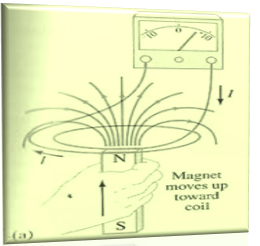Question 1: Describe electromagnetic induction with simple experiments. Explain the factors affecting magnitude and direction of induced emf.
ANSWER
Electromagnetic Induction
The phenomena that whenever the magnetic flux linking a closed loop is changed, there is an induced emf in the loop, is called electromagnetic induction.
Simple experiments to describe electromagnetic induction

1. One experiment was made by M Faraday. Connect a galvanometer to the ends a of coil as shown in the figure. When a magnet is moved towards or away from the coil, the galvanometer shows a deflection indicating a flow of current in the coil. By moving the magnet close or away from the coil is in fact changing the magnetic flux linking the coil which produces current in the coil. Similarly, when north pole is brought near the coil, the galvanometer shows deflection in one direction and when South Pole is brought near the coil, the galvanometer shows deflection in the opposite direction. The direction of deflection of galvanometer is in fact direction of the flow of current. Hence, the direction of flow of current is opposite in case of change of flux by opposite poles. Similarly, by bringing the magnet close to the coil or moving it away from it also change the direction of the current. In case the magnet is held stationary, there is no current in the coil.

2. Another set of experiments show exactly the same results when there are two coils with one connected to a battery (called primary coil). The other coil (called secondary coil) close to the primary coil and connected with a galvanometer. When the current carrying primary coil is moved towards or away from the secondary coil, the galvanometer attached to the second senses a current. Moreover, the relative motion of the primary and secondary coils causes the flow of current. Further, the flow of current in the secondary coil is observed whenever, the current in the primary coil is changed which changes the magnetic flux through the secondary coil. Now changing current or distance between the coils is in fact a change in then magnetic flux which prove the presence of electromagnetism.
3. Consider a loop connected with a galvanometer. Let the loop is moved in a magnetic field. The galvanometer still gives a reading. By moving the loop in the magnetic field is exposing the loop to a changing magnetic flux which induces current in the loop.
Factors affecting magnitude and direction of induced emf
It has been observed through experiments that
- The induced emf lasts as long as the magnetic flux is changing.
- Rapid changes in the magnetic flux cases more induced emf. The magnitude of the induced emf and current is, thus, proportional to the rate of change of magnetic flux.
- Magnitude of the induced emf and current also depends upon the number of turns in the coil and its area linking the magnetic field.
- When the north pole is brought nearer to the coil, the directions of the induced emf and current adjust in such a manner that the face of the coil to the magnet becomes South pole and vice-versa.
Check your understanding!
When the south pole of the bar magnet is brought nearer to the coil, the galvanometer needle is deflected to right. In which direction will it deflect when the north pole of the magnet is moved away from the coil?

Pingback:Comprehensive Questions on Electromagnetic Induction, Physics 12 … msa – msa
Pingback:faradays-law – msa